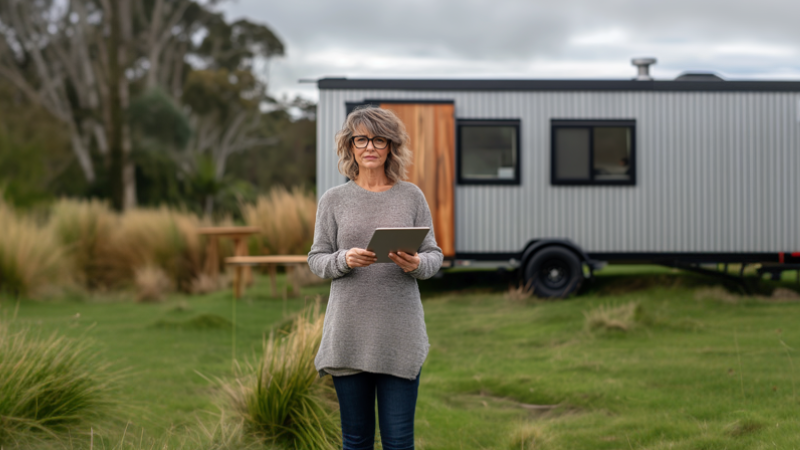You’ve downsized, decluttered, and possibly even crocheted yourself a composting toilet cover. You’ve got freedom, and flexibility. You’re ready to live the dream, park up somewhere lovely, and sip herbal tea while watching the sunrise.
But there’s just one teeny, tiny, not-so-little problem: Where do you actually put the thing?
Turns out, legally parking a tiny house in New Zealand is about as easy as assembling IKEA furniture blindfolded, underwater, and emotionally fragile.
Let’s say you’re a responsible citizen who’d like to connect to power, water, and wastewater like a grown-up. You toddle off to the council, full of hope and maybe a little bit of naivety, only to find yourself trapped in what I can only describe as a consenting labyrinth. It’s all zoning restrictions, resource consents, engineering reports, and something called “stormwater capacity,” which sounds like a weather forecast but costs $17,000 to fix.
Even if the land already has a house on it, adding a tiny one can still trigger the kind of paperwork that makes landowners break into hives. Most will look at the rules, do a quick mental calculation involving stress, time, and council meetings, and say: “No thanks. I’d rather poke my eye out with a teaspoon.”Right, so forget the council then. You’ll go off-grid! Solar panels, rainwater tanks, composting toilets, and enough independence to make Bear Grylls blush.
Except… not so fast. Because even then, the council might still want to have a little say in what you do on your own land with your own pee. There are rules about waste, land use, and whether your humble tiny home is even a “permitted activity.” It’s like your house is a teenager and the council is a very controlling parent who doesn’t want it dating the neighbours.
Rural areas tend to be more chill. Urban zones? Not so much. Basically, the closer you are to brunch cafés, the less likely you are to be allowed to live legally in your tiny home.
Because of all this nonsense, many tiny homeowners just quietly... park. They don't ask, and the council doesn't tell, mainly because they’re too under-resourced to go around inspecting every shed-shaped dwelling behind a hedge.
It’s a bit like a grown-up version of hide and seek, except the stakes are your home, and if you’re found, you might have to move with ten days’ notice and nowhere to go. Delightful!
But honestly, who can blame them? The current rules weren’t designed for people leasing a patch of land for their tiny house. They were designed for big, traditional houses built with bricks, mortgages, and tears.
What Can You Do (Besides Scream Into a Pillow)?
Well, there are a few practical things that might help:
- Check the zoning first – You can do this online, like a tiny house detective with Google Maps and a dream.
- Educate the landowner – Because sometimes, all they know about tiny homes is that episode of Grand Designs where it all went terribly wrong.
- Offer to chip in – If consent is needed, money talks. Possibly mutters, but still.
- Go rural – You’ll have more space, more options, and fewer neighbours judging your compost toilet.
So, if you’re sitting in your tiny home wondering why it’s easier to get a Netflix password from your ex than to legally park your house, you’re not alone. The truth is, tiny homes are clever, modern, and surprisingly good at fitting entire lives into small spaces. The bureaucratic rules? Not so much.
Until councils catch up, and hopefully standardise zoning so we don’t have 1,175 different types across NZ (seriously, Japan gets by with 13, and they build bullet trains) most tiny homeowners will keep finding creative ways to just make it work.


